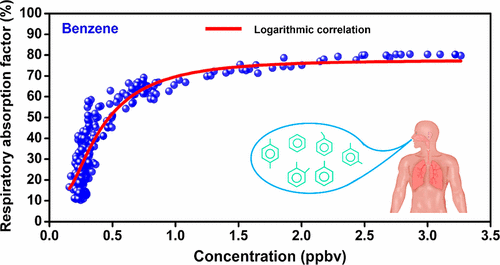当前位置:
X-MOL 学术
›
Environ. Sci. Technol. Lett.
›
论文详情
Our official English website, www.x-mol.net, welcomes your
feedback! (Note: you will need to create a separate account there.)
Decreased Human Respiratory Absorption Factors of Aromatic Hydrocarbons at Lower Exposure Levels: The Dual Effect in Reducing Ambient Air Toxics
Environmental Science & Technology Letters ( IF 8.9 ) Pub Date : 2017-10-25 00:00:00 , DOI: 10.1021/acs.estlett.7b00443 Zhong-Hui Huang 1, 2 , Yan-Li Zhang 1, 3 , Qiong Yan 4 , Zhao-Yi Wang 1, 2 , Zhou Zhang 1 , Xin-Ming Wang 1, 3
Environmental Science & Technology Letters ( IF 8.9 ) Pub Date : 2017-10-25 00:00:00 , DOI: 10.1021/acs.estlett.7b00443 Zhong-Hui Huang 1, 2 , Yan-Li Zhang 1, 3 , Qiong Yan 4 , Zhao-Yi Wang 1, 2 , Zhou Zhang 1 , Xin-Ming Wang 1, 3
Affiliation

|
Respiratory absorption factors (AFs) are important parameters for assessing human health risks of long-term inhalation exposure to low-level hazardous air pollutants. However, it is uncertain whether previously measured respiratory AFs for high-level exposures could be directly applied. Here we measured real-time respiratory AFs using proton transfer reaction time-of-flight mass spectrometry for 50 subjects (20–30 years of age; 24 females and 26 males) exposed in a normal office room with aromatic hydrocarbons (AHs) at concentrations of several parts per billion by volume. The mean respiratory AFs of benzene, toluene, and C8-aromatics (ethylbenzene and xylenes) from all subjects were 28.2, 63.3, and 66.6%, respectively. No gender difference in the respiratory AFs of AHs was observed. Correlation analysis revealed that exposure concentration, rather than physiological parameters like body mass index or body fat ratio, was the dominant factor influencing the AFs of AHs. The results also demonstrated that respiratory AFs decreased in a logarithmic way when exposure levels of AHs were decreased. The decreased respiratory AFs at lowered exposure levels suggest the dual effect of reducing ambient air toxics like AHs with a decrease in human inhalation intake.
中文翻译:

在较低的暴露水平下人体芳香烃的呼吸吸收因子降低:减少环境空气中毒的双重作用
呼吸吸收因子(AFs)是评估长期吸入低水平有害空气污染物对人体健康的风险的重要参数。但是,不确定是否可以直接应用先前测量的用于高剂量暴露的呼吸性房颤。在这里,我们使用质子转移反应飞行时间质谱法测量了正常办公室中暴露于浓度为芳香烃(AHs)的50位受试者(20-30岁; 24位女性和26位男性)的实时呼吸AF。十亿分之几的数量。所有受试者的苯,甲苯和C8-芳族化合物(乙苯和二甲苯)的平均呼吸AF分别为28.2、63.3和66.6%。在AH的呼吸AF中未观察到性别差异。相关分析表明,暴露浓度,而不是诸如体重指数或体脂比之类的生理参数是影响AHs AFs的主要因素。结果还表明,当AHs的暴露水平降低时,呼吸AFs呈对数下降。在较低的暴露水平下,呼吸AF的降低表明减少人体吸入摄入量的双重作用,即减少AH等周围空气中的有毒物质。
更新日期:2017-10-26
中文翻译:

在较低的暴露水平下人体芳香烃的呼吸吸收因子降低:减少环境空气中毒的双重作用
呼吸吸收因子(AFs)是评估长期吸入低水平有害空气污染物对人体健康的风险的重要参数。但是,不确定是否可以直接应用先前测量的用于高剂量暴露的呼吸性房颤。在这里,我们使用质子转移反应飞行时间质谱法测量了正常办公室中暴露于浓度为芳香烃(AHs)的50位受试者(20-30岁; 24位女性和26位男性)的实时呼吸AF。十亿分之几的数量。所有受试者的苯,甲苯和C8-芳族化合物(乙苯和二甲苯)的平均呼吸AF分别为28.2、63.3和66.6%。在AH的呼吸AF中未观察到性别差异。相关分析表明,暴露浓度,而不是诸如体重指数或体脂比之类的生理参数是影响AHs AFs的主要因素。结果还表明,当AHs的暴露水平降低时,呼吸AFs呈对数下降。在较低的暴露水平下,呼吸AF的降低表明减少人体吸入摄入量的双重作用,即减少AH等周围空气中的有毒物质。











































 京公网安备 11010802027423号
京公网安备 11010802027423号